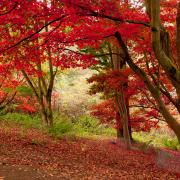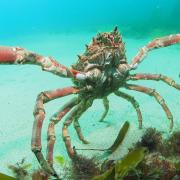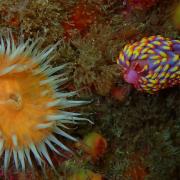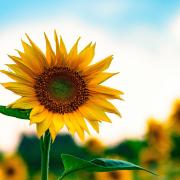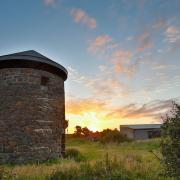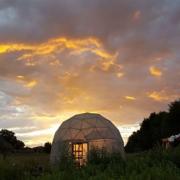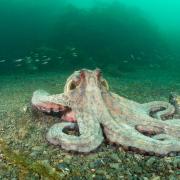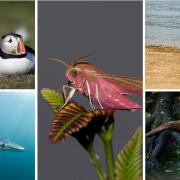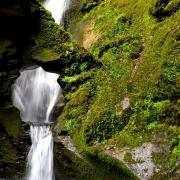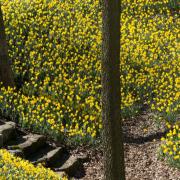There are some stunning discoveries to be made along the coast, as Martin Goodall, Intertidal Discovery Project Manager for Cornwall Wildlife Trust, reveals here.
Cornwall Wildlife Trust is shore to surprise
There are some stunning discoveries to be made along the coast, as Martin Goodall, Intertidal Discovery Project Manager for Cornwall Wildlife Trust, reveals here.
Cornwall’s coastline is famous throughout the world for its stunning views, exhilarating water sports, access to amazing walks, and friendly welcome! It is also home to a huge variety of plants and animals, from microscopic plankton to large marine mammals such as dolphins and seals.The Intertidal Zone is the area of the shore that extends from the lowest to the highest tide marks. It is this area that plays host to a variety of wonderful habitats; from sandy beaches to estuaries and mud flats to rocky shores. These are some of the harshest environments for wildlife to survive in, yet they are also some of the most dynamic and diverse – and many species can be found along the shoreline. Waves, currents, drying out, being preyed upon and changes to the salt concentration in the water and are just a few of the daily challenges that intertidal wildlife must overcome.For such a popular area we know surprisingly little about the habitats found along Cornwall’s coast. In July 2012, Cornwall Wildlife Trust, with funding from SITA Trust, started a two-year project to survey the intertidal habitats along the entire north coast of Cornwall; from Land’s End to Marsland Mouth, near Bude. The data we collect will be used to help educate the public and inform scientific bodies, and ultimately to protect the rarest and most important coastal habitats for future generations.Surveying began in July and we have made some fantastic discoveries! Why not follow in our footsteps and explore Cornwall’s intertidal area and see for yourself why it is so amazing! You can see some pretty breathtaking scenery along the way too…The Intertidal Zone is best explored at low tide. Always check tide times for the area you are visiting, and whilst beaches are great fun to explore, you do need to take care. And remember to avoid disturbing the wildlife, and leave plants and animals where you find them so that others may enjoy them too.
St Agnes
St Agnes is a fantastic example of a rocky shore, and we found over 75 species in our initial survey. If you look in rock pools you might see the colourful snakelock anemones (Anemonia viridis). Its tentacles are often bright green in colour and can have purple tips. You may also see the amazing dahlia anemone, this clever creature often sticks pieces of sand and gravel to itself, to protect it from drying up when the tide goes out.Right at the very bottom of the shore you will be able to see oarweed (Laminaria digitata) which is a type of kelp. It is a large, dark brown seaweed that can be found up to depths of 20 metres. Don’t forget, while exploring the shore line to look out to sea, you may spot a grey seal (Halichoerus grypus)! Britain is home to 40% of the world’s population. You can tell a male from a female because males are larger than the females. Incredibly adults can eat up to 5kg of fish in a day.While you’re exploring along the beach take a look up at the cliffs you might see the beautiful fulmar (Fulmarus glacialis). Their cigar-shaped body and straight wings in flight distinguish them from seagulls. They are members of the albatross family, and although masters of the air they are rather ungainly on land – often seen shuffling along cliff ledges until they reach their destination!If are interested in learning more about the marine environment around St Agnes you can join the St Agnes Volunteer Marine Conservation Area (www.st-agnesvmca.org.uk) which is supported by Cornwall Wildlife Trust.
Mawgan Porth
Mawgan Porth is a lovely sandy beach, and amongst the cliffs on either side there are incredible rockpools waiting to be explored! It’s a great place to spend some time ferreting amongst the boulders looking for fascinating creatures such as the common sea slater (Ligia oceanica). These can be up to 3cm long and are the marine equivalent of woodlice.If you look closely amongst the mussel beds you might see the Celtic seaslug (Onchidella celtica) which is small (around 1cm long), dark-green or black with an oval body and “spikey” appearance. You will also see hidden amongst the mussels a large variety of snails, including rough periwinkles (Littorina saxatilis), dogwhelks (Nucella lapillus) and purple topshells (Gibbula umbilicalis).The back of the beach is also an exciting place to explore as many of our fascinating species get washed-up onto the sand such as the moon jellyfish (Aurelia aurita). This is a clear translucent jellyfish with four purple circles in the centre. Don’t worry, it is not harmful to humans, although other jellyfish can be, so take care!
The Camel Estuary
The north coast of Cornwall has three fantastic estuaries that provide a home to a large variety of species living in the mudflats and sandflats. The largest of the estuaries is the Camel Estuary. This was a huge challenge but very exciting! With the Camel trail running alongside the estuary you can join in and see some fantastic wildlife.Look along the shore and you will see knotted rack, which is also known as egg rack (Ascophyllum nodosum). This brown seaweed has characteristic egg-shaped air bladders at regular intervals along its length. By counting the number of bladders you know will how old it is, as it normally adds one air bladder a year.Amongst the edges of the mudflats you might see very small shore crabs (Carcinus maenas), these little crustaceans can be green, red or brown. Their shell, called the carapace, can be up to 8cm wide and the front is serrated with five ‘teeth’ either side of the eyes.The mudflats of the Camel estuary are also renowned for their amazing bird life and there are many fascinating birds to look out for, in particular the curlew (Numenius arquata) This is the largest European wading bird and you will recognise it by its long, downward curving bill and slender dark legs.
If you would like to learn more about the local wildlife along the Camel Estuary you could join Cornwall Wildlife Trust’s local wildlife group for the Camel, run by experienced and enthusiastic volunteers, See www.cornwallwildlifetrust.org.uk/ groups
We hope you enjoy exploring Corwall’s amazing north coast. To learn more about the work of Cornwall Wildlife Trust and find out how to become a member to support our work please visit www.cornwallwildlifetrust.org.uk. To follow the progress of the Intertidal Discovery Project please visit www.erccis.org.uk/ intertidaldiscovery







